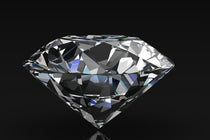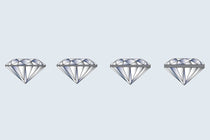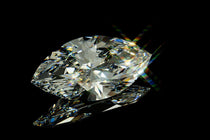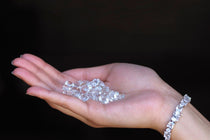Raw diamonds, also known as rough diamonds, are uncut and unpolished gems that have been extracted directly from the Earth.
Raw diamonds, also known as rough diamonds, are uncut and unpolished gems that have been extracted directly from the Earth.
Unlike their polished counterparts, which display a brilliant sparkle and fire, raw diamonds often have a rough exterior and may resemble ordinary rocks or pebbles. However, upon closer inspection, one can identify their distinct crystal structure, usually taking the form of an octahedron or tetrahedron.
When a diamond is still in its natural state, it can be challenging for an untrained eye to differentiate it from other minerals.
Common look-alikes include quartz and calcite, which can exhibit similar characteristics, such as a crystal-like appearance and a rough texture. In order to accurately identify a raw diamond, one must take note of its hardness, specific gravity, and refractive index, among other factors.
To further complicate matters, lab-grown diamonds have entered the market, displaying characteristics similar to mined diamonds but often at a lower cost.
Key Takeaways
- Raw diamonds are uncut, unpolished gems with a distinct crystal structure
- Differentiating raw diamonds from look-alikes requires examining physical properties
- The presence of lab-grown diamonds adds complexity to identifying genuine raw diamonds

Raw Diamond Characteristics
When exploring the world of diamonds, it's essential to understand the unique characteristics of raw diamonds, also known as natural diamonds. These uncut gems differ significantly from the polished diamonds typically seen in jewelry stores.
Color
Raw diamonds can exhibit a wide range of colors, from colorless to shades of yellow, brown, and even rare hues such as blue and green. The color of a raw diamond is influenced by its chemical composition and the presence of trace elements, such as nitrogen or boron.
Clarity
Clarity refers to a diamond's transparency and the absence of internal or external blemishes. In raw diamonds, clarity can vary significantly due to the natural forces at play during the gem's formation. Some raw diamonds may have a high degree of clarity, while others may contain visible inclusions or imperfections that can affect their overall appearance.
Crystal Form
A raw diamond's crystal form is directly influenced by its internal atomic structure. Diamonds naturally form in a cubic crystal system, resulting in an octahedral or dodecahedral shape. However, the actual crystal form of a raw diamond can vary and may display distorted or irregular shapes influenced by the environment in which it was formed.
Inclusions
Inclusions are natural anomalies found within a diamond, such as gas bubbles, minerals, or other microscopic particles. These characteristics can provide valuable information about the diamond's origin, as well as influence its overall appearance and value. Raw diamonds frequently have more visible inclusions than their polished counterparts, as the cutting and polishing process can minimize or remove some of these internal features.
Imperfections
Imperfections, or blemishes, are external flaws present on a diamond's surface. Raw diamonds can have various imperfections, including scratches, nicks, and rough patches, which may affect their overall appearance. During the cutting and polishing process, skilled jewelers can often reduce or eliminate these surface blemishes, enhancing the beauty and value of the finished gem.
Cleavage
Cleavage refers to a diamond's natural tendency to split along specific planes of weakness within its crystal structure. For raw diamonds, cleavage can impact how the gem is subsequently cut and shaped in thecreation of stunning jewelry designs. Jewelers must carefully consider a diamond's cleavage when planning the cutting process, as improper cutting can lead to breakage or a reduction in the gem's overall brilliance.
Distinguishing Raw Diamonds

Visual Inspection
Raw diamonds are minerals and often appear different from polished diamonds; they are usually covered in a layer of dirt or rock. Examining the stone under a bright light and with ajeweler's loupe can help to identify certain characteristics. A raw diamond may possess a rough, crystalline texture and an octahedral molecular structure, in which the diamond's atoms are arranged in a pattern resembling two pyramids joined at the base.
Hardness Test
One way to distinguish raw diamonds from other materials is to determine their hardness using a scratch test. Diamonds are the hardest known material with a hardness of 10 on the Mohs scale; therefore, they should be able to scratch other materials without being damaged. Performing a scratch test using a mineral that has a lesser hardness, such as glass or quartz, can help identify if the stone is a raw diamond. However, some other materials, like moissanite, may be very similar in hardness and require additional testing.
Thermal Conductivity Test
Diamonds are excellent conductors of heat, a quality that distinguishes them from other minerals and synthetic stones. A thermal conductivity tester can be used to test the stone's ability to conduct heat. If the stone quickly disperses heat, it could be a diamond. This method may not be as accurate for lab-grown diamonds since HPHT and CVD diamonds have slightly different thermal conductivities.
Density Test
The specific gravity, or density, of a diamond is an important factor in identifying whether a stone is a genuine raw diamond. The specific gravity of diamond ranges from 3.1 to 3.53 grams per cubic centimeter. By using an electric scale and a container of water, one can determine the stone's specific gravity by measuring its weight in air and then its weight in water. Comparing the results with the known specific gravity of diamond can help you narrow down the identity of your stone.
Common Look-Alikes

Cubic Zirconia and Moissanite
Cubic zirconia and Moissanite are popular diamond simulants often mistaken for real diamonds. Though visually similar, their properties differ significantly. Cubic zirconia is an affordable, synthetic material with a Mohs hardness scale rating of 8.5, while natural diamonds rate a 10. Unlike diamonds, moissanite is a naturally occurring silicon carbide crystal with a hardness scale of 9.25. To distinguish between the three, a thermal absorption test is ideal since diamonds have better thermal conductivity.
Quartz and Feldspar
Quartz and feldspar are common minerals that are sometimes mistaken for diamonds in their raw form. Quartz and feldspar vary in their Mohs hardness scale ratings, with quartz at 7 and feldspar ranging from 6 to 6.5. Diamonds are much harder, boasting a rating of 10. While quartz and feldspar may superficially resemble diamonds, their lower hardness and different crystal structures distinguish them from genuine diamonds.
Herkimer Diamonds
Herkimer diamonds are not genuine diamonds, but double-terminated quartz crystals found in Herkimer County, New York. Despite their misleading name, they are more closely related to quartz than actual diamonds. Herkimer diamonds have a Mohs hardness scale rating of 7, while true diamonds boast a rating of 10. Identifying a Herkimer diamond can be done by examining its double-terminated, hexagonal shape and lower hardness in comparison to a real diamond.
Sources of Raw Diamonds

Cratons and Kimberlite Pipes
Cratons are ancient, stable parts of the Earth's continental crust where diamonds can be found. Kimberlite pipes are the most significant source of diamonds, as they bring diamond-bearing rocks from the Earth's mantle to the surface. These pipes are formed from volcanic eruptions of kimberlite rocks, which contain raw diamonds. The process of erosion can also lead to the transportation of diamonds from their primary source to secondary locations such as rivers and lake beds.
Lamprophyre Dikes
Lamprophyre dikes are another source of raw diamonds. These dikes are formed when magma intrudes into cracks in the Earth's crust and solidifies. Although less common than kimberlite pipes, lamprophyre dikes can sometimes contain diamond-bearing rocks. The minerals found in these rocks can also serve as indicator minerals, guiding prospectors towards potential diamond sources.
High-Pressure Metamorphic Rocks
High-pressure metamorphic rocks also contribute to the formation of raw diamonds. These rocks are formed deep within the Earth's crust under extreme pressure and temperature conditions, resulting in the potential crystallization of diamonds. These diamonds can be brought to the surface by tectonic forces, such as mountain building events, and are then mined.
Meteorites
While not a common source of raw diamonds, some meteorites have been found to contain trace amounts of diamonds. These extraterrestrial diamonds are thought to have formed under the extreme pressures and temperatures present during the formation of the solar system or during asteroid collisions. Although not significant for commercial diamond production, meteorite diamonds provide important insights into the formation of diamonds in various environments.
Lab-Grown Diamonds
Lab-grown diamonds are becoming increasingly popular as a more ethical and sustainable alternative to mined diamonds. They have the same chemical and physical properties as natural diamonds, making them an attractive choice for many consumers.
Creating Lab-Grown Diamonds
Lab-grown diamonds are made using two primary methods: High Pressure High Temperature (HPHT) and Chemical Vapor Deposition (CVD). HPHT involves creating diamonds in a controlled environment with high temperature and pressure, which simulates the natural formation process. On the other hand, CVD uses gas mixtures and a substrate to produce diamond crystals layer by layer. Both methods result in the creation of high-quality diamonds that can becut and shaped into various forms, fromemerald and princess cuts to radiant cut diamond rings.
Ethical Considerations
One major advantage of lab-grown diamonds is the ethical consideration. Mining diamonds often leaves a negative impact on the environment, as well as contributes to unethical labor practices and funding conflict in certain regions. Lab-grown diamonds provide a greener alternative with a lower carbon footprint and minimal damage to ecosystems.
In addition to their eco-friendly benefits, lab-grown diamonds also present a responsible choice for those who wish to avoid contributing to issues associated with mined diamonds. As lab-grown diamonds are created in a controlled environment, they can be easily traced and regulated, ensuring they are ethically produced.
Another important factor for consumers is the distinction between lab-grown diamonds and simulant diamonds. Although both options offer alternatives to mined diamonds, lab-grown diamonds have the same composition and physical properties as natural diamonds. In contrast, simulant diamonds are man-made materials that may resemble diamonds but do not share their true characteristics.
Ultimately, lab-grown diamonds offer a viable and more ethical alternative to traditional mined diamonds, without sacrificing quality or beauty. With a growing interest in sustainability and ethical practices, the popularity of lab-grown diamonds is likely to continue on an upward trajectory.
Rough Diamond Value

Carat Weight
When it comes to determining the value of araw diamond, one factor to consider is its carat weight. Carat weight can significantly impact the price of diamonds, as larger stones are generally rarer and thus more expensive. A natural diamond with a high carat weight may be more valuable than a smaller one, even if the two have similar colors and clarity.
Cutting and Polishing
Another factor that influences the value of uncut diamonds is how well they can be cut and polished. The beauty of a diamond emerges during the cutting process, as a skilled artisan transforms rough stones into stunningjewelry. The shape, proportions, symmetry, and final polish of the diamond all contribute to its overall appearance and worth.
The potential for a real diamond to be cut into a beautiful piece of jewelry also depends on its natural properties. Every diamond cut should maximize the stone's inherent fire, brilliance, and scintillation. A well-executed cut can enhance clarity and mask certain blemishes, ultimately increasing the diamond's value.
Although raw diamonds may be a less expensive option compared to polished stones, the process of cutting and shaping them requires expertise and precision. Consequently, the cost might increase when accounting for labor, equipment, and other expenditures during this transformation. However, alternatives like moissanite can provide a more affordable yet still beautiful choice for consumers.
In conclusion, understanding the factors that contribute to a rough diamond's value, such as carat weight and cutting potential, can help potential buyers make informed decisions when purchasing uncut diamonds.
Notable Raw Diamonds

Cullinan Diamond
The Cullinan Diamond is one of the most famous raw diamonds in the world, weighing a massive 3,106 carats. Found in 1905 in a South African mine, it remains the largest gem-quality rough diamond ever discovered. The raw gemstone's dimensions were astounding, measuring approximately 10.1cm x 6.35cm x 5.9cm. As an uncut rough diamond, its exterior was a mix of various shapes, making it difficult for experts to predict its potential value.
Upon further inspection, the Cullinan was found to have a high-quality octahedral crystal structure, which is ideal for diamonds. It was ultimately divided into nine major stones, including the 530.2-carat Great Star of Africa and the 317.4-carat Lesser Star of Africa, as well as 96 smaller stones.

Sergio Diamond
The Sergio Diamond is another remarkable raw diamond, weighing in at 3,167 carats. It was discovered in 1893 in Brazil and is still regarded as the largest uncut black rough diamond ever found. Its rough appearance and unique black color make it a highly prized gemstone among collectors and enthusiasts.
The crystal structure of the Sergio Diamond is less symmetrical than that of the Cullinan, but its size and rarity give it significant value. Unlike the Cullinan, the Sergio has not been cut into smaller pieces and remains in its natural, uncut form to this day, showcasing the beauty and mystique of raw diamonds.
In conclusion, both the Cullinan and Sergio Diamonds are prime examples ofuncut rough diamond specimens, each with their unique characteristics and history that contribute to their significance within the world of gemstones and jewelry.
Frequently Asked Questions
How can raw diamonds be identified?
Raw diamonds, or uncut diamonds, can have various shapes, colors, and sizes. They typically appear in irregular shapes, such as octahedrons or dodecahedrons, and have a rough texture. Raw diamonds can be transparent, translucent, or opaque, with colors ranging from white and yellow to brown and green. Identifying raw diamonds usually requires expert knowledge and specialized equipment, like a diamond tester or a loupe for close inspection.
What are the differences between raw diamonds and quartz?
Quartz is a common mineral often mistaken for raw diamonds due to its similar appearance. The main differences between raw diamonds and quartz are their structure, hardness, and specific gravity. Diamonds have a cubic crystal structure, whereas quartz has hexagonal. Diamonds are also much harder, with a rating of 10 on Mohs hardness scale compared to quartz at 7. Additionally, diamonds have a higher specific gravity, about 3.5 compared to quartz's 2.7, making them denser and heavier for their size.
Do uncut diamonds have a sparkle?
Uncut diamonds may not have the dazzling sparkle usually associated with polished and cut diamonds. Their raw state and rough surface don't allow for the same level of light reflection. However, a skilled gem-cutter can analyze the raw diamond's structure and strategically cut it to maximize its brilliance and sparkle.
What are common characteristics of raw diamonds?
Common characteristics of raw diamonds include a certain degree of transparency or translucency, rough or granular surfaces, and irregular, often angular shapes. Additionally, raw diamonds can show evidence of trigons or triangular etchings on the diamond's surface. It's important to remember that raw diamonds can greatly vary in appearance, making expert knowledge and professional evaluation crucial to accurately identify them.
How much do raw diamonds typically cost?
The cost of raw diamonds depends on several factors, including weight, color, quality, and market demand. Generally, raw diamonds are priced per carat, with prices varying significantly based on the aforementioned factors. It's important to have raw diamonds appraised by a professional to obtain an accurate assessment of their value. Remember that the final price of a finished diamond after cutting and polishing can be considerably higher due to the added costs of processing and designing.
What methods are used to test for raw diamonds?
Several methods can be used to test for raw diamonds, such as a diamond tester, a scratch test, or a specific gravity test. A diamond tester measures the electrical conductivity of a material to help identify if it's a diamond. The scratch test uses a diamond's hardness to determine its authenticity by attempting to scratch a piece of glass or other known hard materials. The specific gravity test measures the weight and density of a gemstone to help differentiate between diamonds and other minerals. It's essential to bear in mind that professional gemologists and their specialized equipment are best suited to accurately assess and evaluate raw diamonds.
Checkout some of our top collections:
















jester james
February 14, 2024